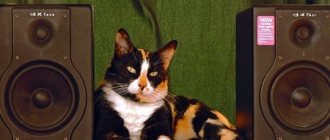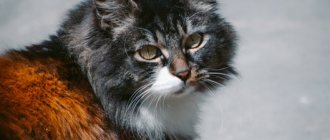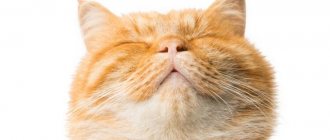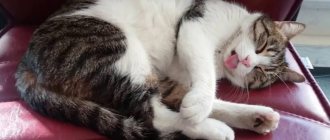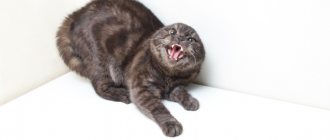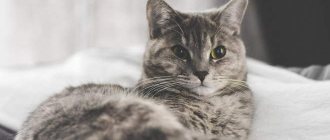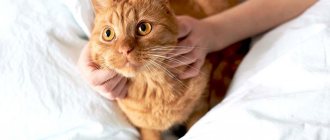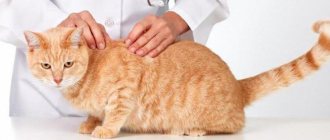Audio communication
Sound communication, for example, is used when greeting hosts, begging for food, or wanting to attract attention by expressing protest or making threats. In each of these cases, the cat makes sounds appropriate to the situation, differing in strength, timbre and tone. Moreover, states of pain, fear, aggression are accompanied by lower sounds, and satisfaction, tenderness or complacency - by higher ones. Cats often communicate with kittens using sounds that are in the ultrasonic range that is not perceptible to the human ear.
Purring means the cat is not aggressive at all. With this short trill, cats call kittens to themselves and greet their owners. A cat makes purring sounds to warn her kittens of danger when she is excited and excited. Rumbling is a warning sound addressed to surrounding people or other animals. A low (uterine) rumbling, almost a growl, is evidence that the cat is ready to defend itself. Another characteristic aggressive sound is hissing. A cat hisses only when it is frightened and does not have the opportunity to escape. Snorting, cats, as a rule, also lean forward a little, as if attacking, and menacingly strike the ground with their paw. This is a signal to fight when meeting with a more serious opponent. Another signal found in a cat's language is the clinking of teeth. Cats rarely resort to it, mainly when they see prey, for example, an unattainable bird sitting on a window, or when teaching growing kittens to hunt. This sound means approximately the following: “Attention! I see prey! Cats use vowel sounds, meowing, in particularly extreme situations. Thus, the sounds “meow”, “mi-au”, “me-au”, “mew” and others express a request, complaint or bewilderment. Cats usually enrich their score, which over time their owners begin to understand. Meowing is conversation. Vowel sounds mean: “I want to go out!”, “It’s time to eat!”, “Feed me immediately!”, “I’m so bored and lonely!”, “Help!” and so on.
“Cat translator” – how does it work?
“Cat Translator” is an Android-based program that can be downloaded from the Internet and installed on a smartphone.
The application is a kind of speech synthesizer, which is based on many years of development by felinologists. Don’t forget that communicating with a cat using an app is more of a game between two interested parties, a person and a pet. To fully decipher messages, you need to take into account not only the sounds made by the cat, but also postures, gestures, and facial expressions.
The “cat translator” contains a huge library of sounds made by furry predators, and the pet reacts to them. The application analyzes the human voice (timbre, intonation, tonality), automatically selects the “words” of the cat’s language and reproduces them for the animal.
The translator contains various options for meowing, there is quick access to recordings of screams and purrs, which greatly facilitates communication with your pet.
The program has a simple, user-friendly interface and a large number of settings. When you open the application, you just need to select one of the animal voices, turn on the record button and say a phrase; the program synthesizes the phrase in “cat language” and voices it to the animal.
Be sure to read:
When kittens change teeth: changing milk teeth to permanent ones, symptoms, how to care, possible complications
Pros of the program:
- A huge library of sounds made by male and female animals.
- Simple controls, user-friendly interface, voice input.
- Possibility of free downloading.
Minuses:
- The application is a game for entertainment and not a full-fledged translator.
- Recorded animal voices can cause aggression on the part of your pet.
- The full version is available only in a paid version.
Communicating with facial expressions
The entire arsenal of gestures with which a cat demonstrates its feelings and intentions, moods and states are innate. Kittens are born with full knowledge of the rules of behavior and instinctively show appropriate reactions. Watching little kittens play, you can notice that in their movements and games, postures and facial expressions there is everything that makes up the sign language of an adult cat.
The cat's half-closed eyes indicate that she is relaxed and at peace. Wide eyes express interest or concern, attention to what is happening around. If the environment causes fear in the cat, then the pupils sharply dilate. Squinting eyes or staring at someone means a challenge. If a cat averts its eyes to the side, it means it is showing its submission. The transition to aggression in a cat is accompanied by a sharp constriction of the pupils and concentration of attention on the subject of aggression.
The ears of cats are no less expressive. Ears facing forward mean that the cat is relaxed, interested in something, or greeting someone; heads horizontally lowered to the sides - aggressive; pulled back and pressed tightly to the head - in fear and confusion. When acting aggressively, the cat lowers its head low, and when in confusion, it lowers its head slightly. Nervous twitching of the ears means irritation or lack of self-confidence.
It is impossible to imagine a cat's facial expressions without moving its eyebrows and whiskers. If they are directed forward, the cat is interested in something, excited or ready for action; loose on the sides of the head - relaxed and calm; collected in buns and pressed to the cheeks - scared or alarmed.
A satisfied cat's mouth is closed or slightly open; as a sign of supreme bliss, especially in Persian cats, the tip of a relaxed tongue may protrude. An open mouth with tense or raised lips in a grin means that the cat intends to bite. Grinning or “Flemin's smile” means examining the odors that interest the cat, usually coming from animals of the opposite sex. And a long, full-mouth yawn exposing almost all the teeth and tongue is complete relaxation. Quickly licking your lips is a sign of anxiety or confusion.
Touch plays a huge role in cat communication. Sniffing and sometimes licking the anal area, temples or mouth is evidence of social hierarchy. A sniffed cat exhibits submissive behavior. Sometimes cats touch noses or press their heads together as a sign of friendship. When a cat rubs its head or body against another animal or makes a figure eight between your legs, it is showing a feeling of affection and sometimes a request for something. If a cat “butts”, rubs its forehead against the forehead of another cat or a person, it means that it is showing an element of intimate affection, which not everyone receives.
Cats use their paws and retractable claws in a very wide range: for exploration, play, hunting and intimidation. When a cat is irritated or worried about something, it strikes sharply with its front paw. In such cases, she does not release her claws, and the strike is preemptive. In this way, the mother cat stops the unwanted behavior of the kittens or the person communicating with her. Cats love to touch their owner's face with a soft touch with their claws retracted. This is how they often express a request to let them under the covers or, on the contrary, wake them up in the morning. Sometimes cats retain an infantile language of postures and body movements for the rest of their lives. For example, a cat, expressing its satisfaction from stroking and caressing a person, can move its front paws in time with its purring. This behavior is typical of kittens when they massage their mother's nipple.
Touch
When two animals meet, sniffing and even licking of the genitals occurs. A cat that allows itself to be sniffed demonstrates submission. The contact of muzzles, noses, and foreheads indicates the pets' friendly attitude towards each other. Butting, biting the skin on a person’s forehead and cheeks speaks of the pet’s strong affection; not all the owner’s relatives receive this honor.
If your pet is spinning under your feet, not allowing you to pass, or rubbing against your legs, perhaps he is not only very happy to meet you, but also wants something else: attention, food, water, playing together. With a blow of her paw, the mother cat besieges the playful kitten, while she does not release her claws. With a soft touch of his paw pads, a cat can wake up its owner in the morning.
Many cats remember their mother's affection and, when stroked by a person, begin to massage the owner, making purring sounds. This is how kittens move their paws when they suck their mother's milk.
Communicating with body movements
Cats are generally very frank in expressing their feelings. The movements of the cat's tail are especially expressive, by which, even without seeing the expression of the cat's face, one can judge the state and intentions of the animal. A raised tail always indicates a cat's friendliness and good mood. Kittens' tails, which are almost always in an upright position, symbolize their interest in the world around them. With its tail raised high, the cat rubs against its owner's legs, greets animals it knows, and invites them to play.
An alert cat's tail is down and ruffled. If the fur on it rises only at the base, the animal does not know what to do. Very frightened cats tuck their tail between their paws.
Aggression is demonstrated by a fully spread, tense and high tail in dominant animals and a lowered, arched tail in subordinates. The first sign of irritation is the rhythmic twitching of the horizontally extended tail. If the tail is down and thumping on the floor, the cat is more scared than angry. But if the movements of the tail increase, the tail twitches from side to side, and the cat begins to lash itself with it on the sides - this is pronounced aggression.
Swinging the tail has several meanings depending on the speed and which part of it is moving: lightly waving the tip of the tail indicates relaxation; the movement of the entire tail is slow at first, and then faster and faster, so that the cat’s croup begins to sway, occurring before jumping on the object of the hunt.
Is it possible to teach a cat to speak like a human?
Surprisingly, domestic cats can be trained to speak like humans. Precisely cats, not females, since the vocal apparatus of males is more flexible. You need to start gradually and from an early age - kittens remember and adapt to everything new with greater success than adult cats.
The pet will not be able to clearly pronounce any words, but everything that is similar to the word “meow” is within its capabilities. The most popular word in training is “meat” - owners who have managed to teach their pet to at least remotely pronounce this word recommend calling it before, during or after eating. Some advise saying the word “meat” an hour before meals and while serving food. You need to pronounce it clearly and clearly, looking your pet in the eyes.
Communication and understanding form healthy relationships not only among people
If your pet succeeds, be sure to treat him and praise him for his successful attempt. If it doesn’t work out, don’t insist, much less scold, but return to learning later.
Understanding your pet is not difficult: you just need to take a closer look at its behavior and observe how the cat behaves in different situations. How does a pet behave when it wants to eat? When you're angry, tired and don't want to be petted? All this is of great importance if you want to establish long-term and mutual contact with your pet.
Cat poses
The cat's poses are also unusually expressive - graceful, flexible and absolutely unambiguous. The cat's pose not only expresses its own state, but also depends on who it is addressed to. For example, a warning to a strong opponent (a dog) in the form of a threatening pose is different from the pose with which a cat meets an aggressive fellow tribesman.
The classic threat pose of a cat allows it to appear larger and more impressive in the eyes of its opponent. All four paws of the cat are tensely extended, it seems to be standing on tiptoes, its back is arched, its tail is curved, and the hair on its back and tail stands on end. You may notice how an excited or frightened cat's cheek nodules move, and the hair rising above them makes the head visually appear larger. The threat is complemented by appropriate facial expressions: the ears are pressed to the back of the head, the nose is wrinkled, the fangs are exposed, the corners of the mouth are pulled back. The cat purrs and periodically hisses.
Cats very accurately track the so-called “flight distance”: the distance from the enemy to the cat that no longer feels safe. The cat demonstrates a threatening pose, but does not proceed to an active attack, preferring to escape. But if the warning did not work, and the enemy continues to approach the cat, but it cannot flee, then the cat rushes to attack as soon as the enemy breaks the “distance of aggression.” The exception is a mother cat who protects her offspring. For her there is no “flight distance”, and the “aggression distance” coincides with the limits of visibility. In this case, she is the first to rush towards the enemy. The cat jumps on all four legs, straight and extended, while remaining turned sideways to the enemy, with its fluffy tail held high. This pose signifies readiness to fight to the death.
The threatening poses of cats about to compete with each other look completely different. In this case, they are less threatening, the cats practically do not hunch their backs and do not bristle their fur, but only fluff it slightly on the withers and tail. Not keeping a distance, they stand on outstretched legs, nose to nose, looking into each other's eyes, purring and howling. In this position, cats remain motionless for a surprisingly long time, trying to suppress the enemy's morale. Only the blows of the tail on the sides indicate that a fight can happen at any minute. This is followed by the first paw blow to the nose. The attacker seeks to inflict a bite on the back of the enemy's head, and if he succeeds, the captured animal falls on its side. If a cat wants to avoid a power fight, then it takes a pose that combines elements of submission and threat. The cat presses itself into the floor, lies on its side or back, putting out all four paws with extended claws towards the enemy, taking a defensive position. The fight ends abruptly, with the winner being eliminated first, trying to retain as much dignity as possible.
In relationships with people, cats rarely carry out their most violent threats. Living with a person for a long time has developed inhibitions in the cat that inhibit its aggressive behavior. It’s a completely different matter if the cat is threatened by a stranger. In this case, the defending cat can seriously injure the person attacking it.
Very gracefully and elegantly, cats express their satisfaction and complacency. The most striking demonstration of this condition is when the cat lies relaxed on its side or back, showing its exposed belly. At the same time, her paws are spread out to the sides, their pads can be compressed and unclenched, the claws are deeply hidden. In a calm state, the cat's eyes are half-closed, the third eyelid is often visible, and the pupils are constricted. This pose shows others that the cat trusts them completely. This situation is also typical for the mother cat. The same pose is taken by a cat that has warmed up in the sun or near a heat source.
The cat shows its indecision in a very interesting way. A cat's state of insecurity is always accompanied by licking its fur (as Paul Gallico wrote in his book about cats, Rejected: “If you don’t know what to do, wash yourself”). The more decisive the movements of the tongue, the more complex the problem the cat solves to itself at that moment. Licking calms her down, neutralizes emerging irritability and the desire to show aggression. A cat often licks its cubs and other animals living with it. And this is always a sign of goodwill and a call for calm.
Voice signals
Most often, cats convey information using their voice. This is how they protest, threaten, beg for a treat, or attract attention. For each situation, the cat has a corresponding set of sounds. The vocal abilities of cats are very impressive. In terms of pitch, the animal can produce sounds in the range from 75 to 1520 Hz. Fear and aggression sound “low,” while higher sounds are used to express pleasure and tenderness. The mother cat generally communicates with kittens in the ultrasonic range, which the human ear cannot perceive.
There are at least sixteen different sounds used by cats. Moreover, the “talkativeness” of a cat may depend on the breed. For example, Siamese and Oriental cats “communicate” most often. Purring and rumbling are generally characteristic only of small cats; their larger counterparts practically do not use such sounds.
The purr of a cat is a symbol of sympathy and good-natured disposition. Purring, the cat calls the kittens. Rumbling, on the contrary, warns kittens about danger, and the cat also communicates its aggressiveness and readiness to get into a fight.
Oddly enough, hissing is not a sound of aggression, but rather a symbol of fear and the inability to escape. If snorting and hissing are accompanied by forward movement of the body, this is a signal for a fight. But more often, snorting indicates doubt: fight or run?
Cats rarely resort to a signal such as teeth chattering. Basically, this is a reflex when seeing prey that is out of reach of the animal. The cat chatters her teeth when she teaches her kittens to hunt, literally “I see prey!”
A cat's meow is a conversation. Vowel sounds express a request, complaint or bewilderment, for example, “let me out”, “I’m hungry”, “I’m bored”, “help”. Each cat is individual in the manner of meowing.
Newborn kittens acquire their “vocal” abilities gradually, learning from adult animals. As a rule, a kitten can produce a full range of sounds by the age of three months. Further, the palette of sounds can be enriched under the influence of personal experience, training and the external environment.
Smells
One of the elements of “social” behavior, which also develops during previous experience, is marks. Tags for cats are a whole book closed to us.
In addition to the traditional sniffing ritual when two cats meet (mostly the anal glands are sniffed), cats have scent glands around the eyes, on the chin and behind the ears. Cats use their facial glands to mark objects that are their property, such as door frames, marking territory, or your legs.
In “social” behavior, an important role is played by the secretion of the sebaceous gland, located at the upper edge of the base of the tail (in cats it is larger than in cats). When a cat makes figure eights between your legs, it leaves marks on your legs. Cats leave similar marks with saliva, but unlike the marks of the anal, caudal and facial glands, saliva does not convey information about changes in the sexual behavior of cats (for example, the onset of estrus in a cat).
Small odorous glands are located in the cat's interdigital spaces. The smell from them remains when the cat sharpens its claws. By leaving scratches in permanent places, cats thus “hang out” visual and odorous “ads” indicating the boundaries of its territory.
Visual and odor marks include urine and feces, which cats generously fertilize their territory with. Based on them, it is not difficult for a fellow tribesman to guess who left them, what gender and when, whether the cat is in heat, what level of the hierarchical ladder the animal is on, and even where food is hidden for a “rainy day.”
By looking at the feces, you can tell what rank the animal occupies on the hierarchical ladder: a cat that has its own territory never buries its excrement on it. The vast majority of cats recover in a place specially designated for this by a person - the cat litter box. They usually bury their feces, thereby recognizing their submission. From the cat's point of view, you are a highly dominant creature, since you are gigantic in size compared to her, and you take care of her food and care for her.
Urine markings most often serve as a means of “social” behavior. Cats leave their urine marks everywhere: on bushes, walls, poles, on chair legs, on curtains. The message written in urine disappears after a day, which is probably why cats update it daily, walking around their own property. This is not meant as a warning or threat, but rather as a calling card noting who left it and when. Urine marks provide a warning that an area is occupied and can help avoid unnecessary confrontation between cats when entering someone else's space. It should be noted that naturalized (castrated) animals use visual and odor marks to a lesser extent.
Learning the cat's love language for its owner: 13 basic gestures
Cats master human language faster than people: scolding or praising an animal. It is more difficult for people to understand that a cat is happy to see its owner, loves and trusts him.
Cats can show their love for their owner in such a way that the owner does not understand the pet and scolds him for rude affection. The thing is that for an animal, biting or scratching is a characteristic gesture that signifies affection.
To learn the “cat language” the owner needs constant attention and boundless patience. The most accessible language to study is sign language; changes in the position of body parts clearly demonstrate the emotional state of a pet.
So, let's study the sign language that means love:
- A gentle purr with a narrowed gaze, intended exclusively for the owner.
- Rolling from side to side, demonstrating the abdomen means the highest degree of trust.
- Pushing the head (“butting”) expresses love for a person or another animal.
- Trampling with paws on the owner's body indicates the pet's complete trust.
- Gifts brought to the owner (a game ball, a strangled mouse or a caught bird) mean adoration.
- The cat makes an offer to join the game to his loved one.
- If the cat lies down on its lap, it means the animal loves and trusts its owner.
- A long, squinting cat gaze can be equated to a declaration of love.
- The cat exposes its furry butt to the owner, this is how the pet demonstrates love and trust. Kittens turn their backs to their mother every time they meet.
- Meowing means that the pet wants to “talk” to its loved one.
- The cat licks the hands and feet of the owner, which means the person is recognized by the animal as a member of the family group.
- A fluffy tail raised up indicates joy from meeting the owner.
- Biting hands means delight and adoration.
Be sure to read:
The cat has dilated pupils: physiological and pathological reasons, when to sound the alarm, treatment
Cat love can be expressed in ways that are completely unacceptable to humans. Some cats mark things or the sofa of their beloved owner, others sharpen their claws on furniture and wallpaper, showing the owner that they are comfortable and safe in the house. It is not at all easy to wean a pet from loving its owner this way; the cat does not understand why he is being scolded or punished.
The cat is rubbing against you
The cat approaches you, arching its back, raising its tail (sometimes it moves) and, as it were, runs along your legs, starting from the muzzle, then sideways and at the end turns to you with its raised tail, wrapping it around your legs, and so on several times. Thus, the cat exchanges smells with you, which for it is tantamount to an exchange of information; the cat is friendly, it’s like a friendly handshake and the expectation of affection in return. This movement is learned by cats from infancy, when the mother cat comes to communicate with her babies in the nest. She gently purrs and licks each kitten, starting from the forehead, then the back and ending under the tail, at the same time caressing and washing her babies, because they are still small and cannot clean themselves. Perhaps, after such a greeting ritual, the cat will step aside and begin to lick itself; it licks your scent off itself, as if “tasting” it.
Cat's dictionary
- He stretches out his paw to your face - asks for attention and affection (“well, do you still love me a little?”).
- She tramples with her paws and extends her claws a little - she’s very, very happy, she wants to please you, she loves you very much.
- Stroke a person with his paw - close affection, tenderness.
- Rubbing your head against a person is love, devotion, sincerity, a thirst for affection, and also a sign of estrus.
- Squinting your eyes demonstrates peacefulness and calmness - “everything is fine.”
- Wide-open pupils - fear.
- Large eyes and pupils - peers into the darkness, is afraid, angry or plays.
- Staring at you - a challenge (usually a game of catch-up).
- A third eyelid appears - the cat is sick or wants to sleep.
- He quickly licks his nose and lips - in confusion (we would scratch the back of our heads).
- He quickly licks his front paw - he is worried, indecisive - “how can this be?”
- She looked around and carefully licked herself - complete or feigned (during play or hunting) calm - “I’m just washing my face here.”
- A tail frozen at the bottom - disgust, disappointment - “what disgusting!”
- Beats his tail - he is angry or hunting - “better not come near.”
- Tail with a trumpet - greeting, pleasure - “I’m so glad!”
- Moves the tip of his tail - interest - “what is so interesting here?”
- The tail raised vertically has a relaxed tip - joyful excitement - “hurray!”
- Strong tail swishes in different directions are irritation, while small tail wags indicate excitement and curiosity.
- Ears pressed to the head - preparation for an attack.
- Ears pressed to the head, tail making circles - irritation.
- Ears upright - curiosity.
- Ears flat to the sides - hiding, flirting - “hey, you can’t see me.”
- Ears back, eyes big - a warning - “I won’t tolerate it.”
- Ears back, eyes squinting - impatience, request - “well, hurry up, I really want to.”
- The whiskers are directed forward - the cat is interested in something, excited or ready for action.
- The mustache is loose on the sides of the head - relaxed and calm.
- The mustache is gathered in bunches and pressed to the cheeks - scared or alarmed.
- Mustaches down - preoccupied, sad or sick.
- Scratching loudly with its claws - a desire to attract attention.
- Arches the back, especially if accompanied by a deep grunt, constrained movements or direct gaze into the eyes - intimidation of the enemy, very strong irritation and readiness to defend.
- The cat presses itself to the ground - hiding or preparing to attack. He dances, lifts his front paws off the ground and puts them back - greeting someone beloved and long-awaited.
- A cat rubs against your legs and marks you. Cats have scent glands on their faces. All relatives should have a familiar and comfortable smell!
- It turns its back to the owner's face and raises its tail - a common greeting gesture between well-known cats, a sign of trust and respect; the dominant cat sniffs first.
- Lies on his back with a thoughtful look - ventilating, resting (this funny position is typical for Siberians and other cats that have more warm downy hair on their stomachs than on their backs).
- She sits with her paws tucked in, her tail turned around - watching, relaxed, waiting.
- He hides his head in some corner of the game - “screw me, I’m hiding.”
- She runs away from you, pulling her head into her shoulders, on long legs, knowing that she has done something wrong - “I’d better go.”
- Rolling around on the floor - demonstrating his attractiveness.
- Bent front paws - a preference to avoid a fight, but if necessary, resist.
- Fully extended paws - self-confidence, readiness to attack.
- Bent hind legs - uncertainty or even timidity.
- Purring - calmness.
- Dissatisfied purring is a painful sensation.
- Rumbling is dissatisfaction.
- Meowing is a greeting and sometimes a request.
- An intermittent meow, similar to a squeal, is a response to human treatment.
- Howling is anger.
- A short cry is fear.
- Muffled purring, ending with a dissatisfied rumbling - patience has run out.
- Hissing is a readiness for defense, a warning about this.
- The restrained purr of a nursing cat is a warning to kittens about possible danger. The same thing, ending in a raised tone, is a warning to a person or other creatures not to approach the kittens.
Cat sounds
First of all, any owner pays attention to the sounds made by the cat. Everyone knows that a cat's purring shows that it is calm and happy. But if there are notes of displeasure or anger in the purring, your cat may be trying to tell you that she is feeling bad or in pain: you should consult a veterinarian.
Common cat sounds:
- Cats use meowing to communicate only with humans. Usually “meow” means some kind of request or greeting, and intermittent meowing is a response to an appeal to a cat;
- A cat purrs when it is dissatisfied with something;
- The cat hisses, warning of readiness for defense;
- Howling means anger;
- The cry of a cat is a strong fright;
- If a cat purrs muffledly when feeding her kittens, she warns them of danger; if a cat purrs in a loud voice, this is a threat to a person or animal approaching her offspring.
Young kittens learn by gaining experience from their mother and the environment, and by about three months of age they acquire the necessary communication skills.

